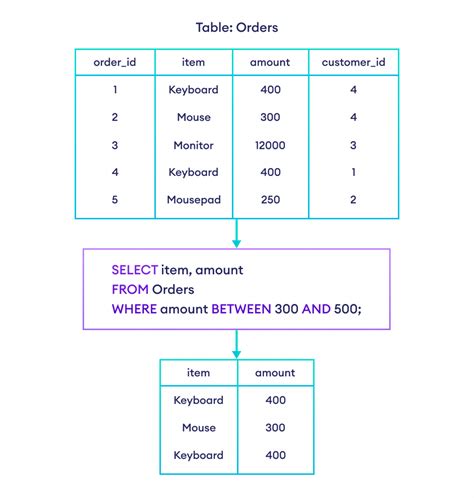The SQL `BETWEEN` operator is a powerful tool used in SQL queries to select values within a given range. Understanding its inclusivity is crucial for accurate data retrieval. The `BETWEEN` operator is used in the `WHERE` clause of a SQL statement to filter the data based on a specified range. It selects values that are greater than or equal to the first value and less than or equal to the second value.
SQL Between Operator Syntax

The basic syntax of the BETWEEN operator is as follows:
SELECT column_name FROM table_name WHERE column_name BETWEEN value1 AND value2;
In this syntax, value1 is the lower bound of the range (inclusive), and value2 is the upper bound of the range (inclusive). This means that any row with a value in the specified column that falls between value1 and value2, including the bounds themselves, will be included in the query results.
Inclusivity of SQL Between
To directly answer the question: yes, the SQL BETWEEN operator is inclusive. This means it includes the start and end values specified in the query. For example, if you run a query like:
SELECT * FROM employees WHERE salary BETWEEN 50000 AND 100000;
This query will return all rows from your employees table where the salary is between 50,000 and 100,000, including employees who earn exactly 50,000 and those who earn exactly 100,000.
Key Points
- The SQL `BETWEEN` operator is inclusive, meaning it includes the start and end values in the range.
- The syntax for using `BETWEEN` involves specifying the column name, the lower bound of the range, and the upper bound of the range.
- The `BETWEEN` operator can be used with various data types, including numbers, dates, and strings, but the data type of the values must be compatible with the column being queried.
- Care should be taken when using `BETWEEN` with dates and timestamps, as the inclusivity can sometimes lead to unexpected results if not properly considered.
- For numeric ranges, the `BETWEEN` operator is particularly useful for filtering data based on a continuous range of values.
Using Between with Different Data Types

The BETWEEN operator is not limited to numeric values; it can also be used with dates and strings. When using BETWEEN with dates, it’s essential to consider the time component if the column includes time. For strings, the comparison is done lexicographically (alphabetically), which can sometimes lead to unexpected results if not carefully managed.
Example with Dates
For example, to select all records from a table where the date falls between ‘2022-01-01’ and ‘2022-12-31’, you would use:
SELECT * FROM orders WHERE order_date BETWEEN ‘2022-01-01’ AND ‘2022-12-31’;
This query will include all orders made in the year 2022, assuming the order_date column only contains dates and no time component.
| Data Type | Example Usage |
|---|---|
| Numbers | `SELECT * FROM employees WHERE salary BETWEEN 50000 AND 100000;` |
| Dates | `SELECT * FROM orders WHERE order_date BETWEEN '2022-01-01' AND '2022-12-31';` |
| Strings | `SELECT * FROM products WHERE product_name BETWEEN 'Apple' AND 'Banana';` |

Considerations and Best Practices
While the BETWEEN operator is a powerful tool, there are considerations to keep in mind. For numeric values, the inclusivity of the operator means that values exactly equal to the bounds will be included. For dates and timestamps, ensuring that the time component is correctly handled is vital. With strings, understanding that the comparison is lexicographical and can be case-sensitive (depending on the database system) is important.
Conclusion
In conclusion, the SQL BETWEEN operator is a versatile and useful tool for filtering data within a specified range. Its inclusivity of both the start and end values makes it particularly useful for a wide range of applications, from selecting employees within a certain salary range to filtering orders within a specific date range. By understanding how the BETWEEN operator works and considering the data types and potential pitfalls, developers can leverage this operator to efficiently and accurately retrieve the data they need.
Is the SQL BETWEEN operator case-sensitive when used with strings?
+The case sensitivity of the SQL BETWEEN operator when used with strings can depend on the database system being used. Some systems are case-sensitive, while others are not. It’s essential to check the documentation for your specific database system to understand its behavior.
How does the BETWEEN operator handle NULL values?
+The SQL BETWEEN operator will not match NULL values. If a column contains NULL and you use BETWEEN to filter the data, rows with NULL in that column will not be included in the results.
Can the BETWEEN operator be used with other operators in the WHERE clause?
+Yes, the BETWEEN operator can be combined with other operators in the WHERE clause using logical operators like AND, OR, and NOT. This allows for more complex and specific data filtering.
